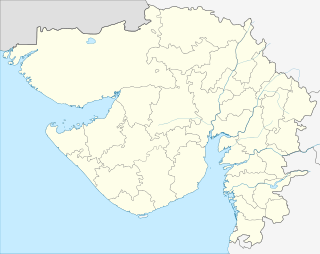Manek Burj
| Manek Burj | |
|---|---|
| માણેક બુરજ | |
 Ellis Bridge from the top of Manek Burj | |
 Manek Burj Location in Gujarat, India | |
| Etymology | Maneknath |
| General information | |
| Type | Bastion of the city wall |
| Location | East end of Ellis Bridge |
| Town or city | Ahmedabad |
| Country | India |
| Coordinates | 23°01′20″N 72°34′38″E / 23.0221373°N 72.577357°E |
| Named for | Maneknath |
| Construction started | 1411 |
| Renovated | 2003 |
| Height | 53 feet |
| Dimensions | |
| Circumference | 77 feet |
| Technical details | |
| Material | Bricks and mortar |
Manek Burj (literally Ruby bastion) is the foundation bastion of the Bhadra Fort of the old city of Ahmedabad, Gujarat, India.[1]
Etymology
It is named after 15th century legendary Hindu saint Maneknath who interrupted and helped Ahmed Shah I built Bhadra Fort in 1411.[2][3][4][5]
History
As it was the foundation bastion of Ahmedabad, it was laid down on 26 February 1411 by Ahmed Shah I. It was round the foundation stone of the city. The bastion, on the outside fifty-three feet high, used to contain a stepwell known as the Manek kuva, seventy seven feet round. By a change in the course of Sabarmati river the stepwell became dry and in 1866 was filled up. There was a water channel near bastion which brought water to royal baths in past.[6][7] In 1869, the Ellis Bridge, the first bridge across the river was constructed near the bastion. Later Ahmedabad Municipal Corporation declared Ellis bridge and its boundary, Manek Burj and the natural water drain near one of the banks of Sabarmati river as protected sites in May 1989. The original steel bridge was narrow and not suited for heavy motorized traffic and so it was closed in 1997 and the new concrete bridge was constructed on either side of the steel bridge in 1999. The bastion was partially broken for expansion of the bridge.[1][8][9] After earthquake in 2001 and riots in 2002, many people believed that the city suffered due to the damage to the bastion. So the bastion was restored in 2003.[7]
Culture
Chandan and Rajesh Nath; the 13th generation descendants of the saint, performs puja and hoists the flag on Manek Burj on the foundation day of the city and Vijayadashami every year.[10][3][4][7][11]
References
- 1 2 "Ahmedabad's quiet birthday at Manek Burj". dna. 27 February 2013. Retrieved 7 January 2015.
- ↑ Desai, Anjali H., ed. (2007). India Guide Gujarat. India Guide Publications. pp. 93–94. ISBN 9780978951702.
- 1 2 More, Anuj (October 18, 2010). "Baba Maneknath's kin keep alive 600-yr old tradition". The Indian Express. Retrieved February 21, 2013.
- 1 2 "Flags changed at city's foundation by Manek Nath baba's descendants". The Times of India. TNN. October 7, 2011. Retrieved February 21, 2013.
- ↑ Ruturaj Jadav and Mehul Jani (February 26, 2010). "Multi-layered expansion". Ahmedabad Mirror. AM. Retrieved February 21, 2013.
- ↑ Gazetteer of the Bombay Presidency: Ahmedabad. Government Central Press. 1879. p. 276.
- 1 2 3 Shastri, Parth (27 February 2011). "Ahmedabad says abracadabra". Times of India Publications. Retrieved 7 January 2015.
- ↑ "Bridges - To past, present & Future". Ahmedabad Mirror. 4 February 2010. Retrieved 4 April 2013.
- ↑ John, Paul (2 September 2011). "Hope lies in Ellisbridge". The Times of India. Retrieved 4 April 2013.
- ↑ Laxmi Ajay (27 February 2015). "Ahmedabad city turns 604". The Indian Express. Retrieved 21 October 2016.
- ↑ "Manek Burj's sorry state fails to move AMC". DNA. 19 April 2012. Retrieved 7 January 2015.
- This article contains public domain text from Gazetteer of the Bombay Presidency: Ahmedabad. Government Central Press. 1879. p. 276.